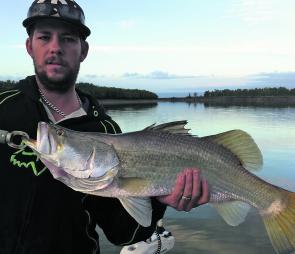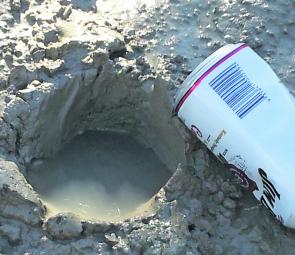As we travel to our favourite winter barra spots I laugh about the far north boys saying that barra won’t feed if the water temp is under 25ºC. We must have Eskimo barramundi around here because they will chew nearly all year round.
Plenty of times already this year we have caught fish when it is way too cold for a swim. Dressed in woollies with a beanie, gloves and wearing wetsuit boots is not normal barra fishing attire. It is just a matter of timing the tide, the wind and the spot. When it all comes together you will catch barra.
After saying all that, I do prefer those warmer winter days to the cold ones.
In the upper Fitzroy town reaches the water immediately around the rocks can be slightly warmer than the surrounding areas because the sun heats the dark rocks like solar panels. Downstream I also find that the fish tend to line the rock walls and we score far more fish on average than fishing deep timber, which is usually the best in summer. If you have a modern sounder you can see the thermoclines in stiller waters. The fish will tend to congregate more in the warmer level nearer to the surface in winter. Shallow divers, poppers and surface lures are the go most winter days.
King threadfin salmon are very active at present along the entire length of the river, as evident by the dents they leave in the banks. I continually look for these impressions they leave as they punch their noses deep into the mud to grab or chase out crabs and prawn fry. When a king has worked an area the fresher digs will have sharp edges and when the next tide comes through it will round them off. We saw one smashing the banks in the very shallow water but it was so gorged on crab it didn’t take any notice of the prawns and lures we put right in front of it.
When the tide receded, it showed the holes the salmon left in the bank were everywhere. The small gutters that come down into the main waterway are often a good hiding spot for these fish as they often lay in wait for a feed to wash past them.
Big flathead are congregating in the creek mouths and the deeper channels leading into the bay at present. It coincides with the large schools of herring and hardiheads that have flooded around the islands and places like Corio Bay. It pays to be aware of bottom structures and features, which offer shelter to the different species and create ambush spots where predators lie in wait for the prey fish to travel past.
We often slow troll lures down a stretch of the channel working out where the holes, logs, rocks, gutters and rubble beds are while still fishing. Many times you can crack a good flatty or two on the troll and then go back to chuck a few plastics at the features marked later.
Low tides are a great time to walk the banks throwing plastics or small hardbodies into the pools between banks, looking for spots where the big flathead move up onto the banks with the incoming tide. You can spot the lays where they move and stop at each part of the rise. This gives you a great idea of where they will be at any particular time of the tide and you can apply these same tactics to anywhere you fish.
Bream continue to show in large numbers once again in almost every creek locally. Corbett, Kelly, Waterpark Creek, Fishing Creek, Corio Bay, The Bluff Rocks, Ross Creek, Stevensons Rocks, Wreck Point, Double Heads, The Causeway, Coorooman Creek, Pumpkin Creek, The Fitzroy River and the Narrows are among the many great bream spots. All the local headlands also do very well for giant bream over cold times.
At the moment virtually any fresh frozen bait will do the trick for bream, although small live hardiheads and yabbies have an edge. Steelbacks or flat salmon are in big numbers lately, working the surface eddies and current lines at Coorooman and Corio. Although the bigger fish don’t taste too bad they make a fine troll bait for Spanish mackerel. They love small bright lures or livies and can be quite annoying when they gang up on bigger livies meant for another species.
August usually produces light westerlies and generally the odd smaller southeaster. This allows the bay to clean up bringing in the lesser mackerel, like doggies, greys, a few spotties and the odd large Spanish mackerel.
Doggie mackerel are the word on the street of late. Spots like Ritamada, Findlays, Ironpot, Farnborough, Bangalee, Quartz, Claytons, Forty Acre Paddock, Conical, Outer and Barren are all pretty good when the dogs move in and best of all most spots can be seen from shore. If you see boats gathering in a particular area, that means the fish are on. Flashas and floating pillies are both good options depending on how you like to fish.
Ribbonfish have been coming on at several of the local mackerel spots lately. Quartz, Ironpot, Double Heads and Corio have had their fair share of these great bait ish. Now there is a bag limit it makes it hard to stock up for later in the year. Consequently, we get just under the limit (10 per person in possession) in the freezer at home and get some fresh ones on the way out for the day. They make excellent troll baits for Spanish and top strip bait for reds, nannies and black jew.
Some guys like to pre rig the ribbonfish before freezing them, in case the mackerel are on a hot chew when they are bought out next time. This can save lots of time and you have the ability to keep a bait in the water. The other tip is to wrap each fish separately in cellophane, as this stops them sticking together and helps stop freezer burn.
Small flashas, feather jigs and fluoro, gold or chrome divers can all catch ribbonies. I put the next size hooks or a wider gape treble to help with more hook-ups. These guys have an unmatched ability to get off a hook. Keep a rag hand, their other name is snotty because they are slimey buggers.
Reefies are in good form, as they should be for much of the year. The ‘w’ in the wind direction affects them in the closer areas but the catches offshore don’t change a lot. I prefer to let the morning winds drop off in the cooler months and head out for an afternoon session. The majority of times we do better than the early morning starts offshore.
Black jew have also been in good form the past month or so, and as long as the weather is okay the jewies will be around. The deeper spots hold the odd black jew most of the time but the inshore jew holes come to life around 3-4 days before and after the moon. When the doggies and ribbonfish are here they make the best jew baits, the rest of the time squid, pillies and mullet strips are the go.
Reads: 2214
Abby from KBSFC with a great local salmon.

Kerrie Lauga with a great barra caught and released in the fresh reaches of the Fitzroy River.

This Fitzroy River barra was caught by Trent Lauga.

Notice the sharp edges on the hole left by a big king salmon that was chasing crabs on a fuller tide. A great indicator of where to fish.




